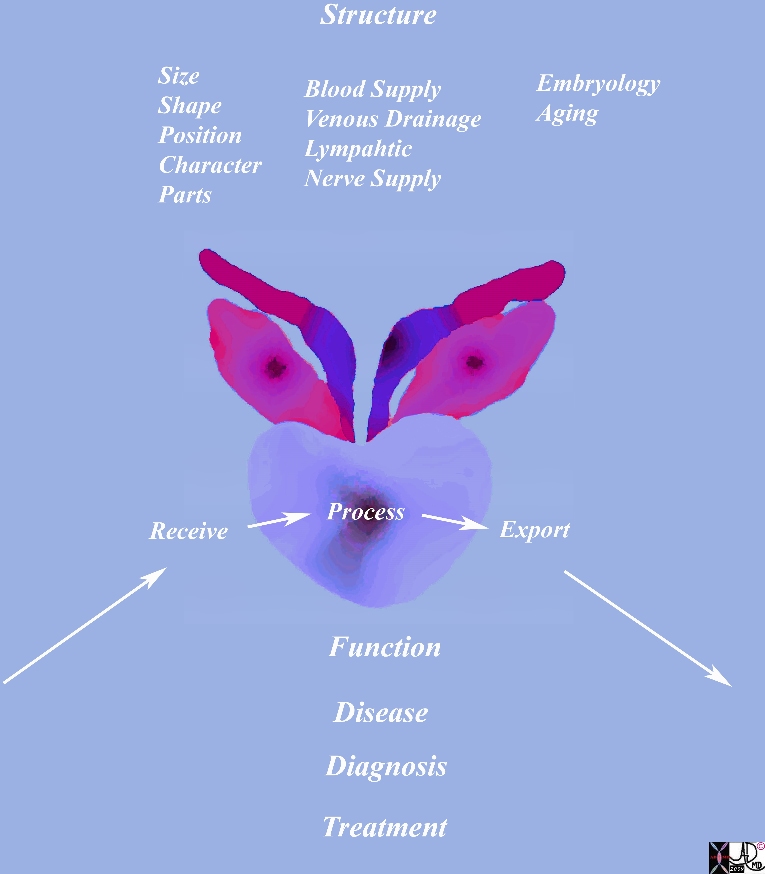The Common Vein Copyright 2010
Introduction
There are universal principles that govern all biological structures
The principles of structure are in part reflected in the adjectives used to describe them including size, shape, position, character. Biological structures are made of smaller parts and are usually surrounded by a protective capsule. Structures that connect the prostate to the rest of the body include the blood vessels, lymphatics, ducts and nerves. As a biological structure the prostate undergoes changes in time that include the changes that occur in its early development and then in aging.
Biological structures function by receiving raw products, processing and producing, and then exporting products that are useful to the organism.
Disease is the alteration of structure and or function, while diagnosis aims at identifying these structural and functional abnormalities, and treatment aimed at relieving the aberrances.

Principles of the Prostate |
|
This diagram frames the underlying principles and approach to the prostate in this module. Universal structural principles include size, shape, position character and parts with connections to the rest of the body via blood vessels, nerves and lymphatics. All structures are subjects to the influences of time both in their development and in their aging process. Physiological principles include receiving raw products processing and producing and exporting an end product. Disease is an aberrance of structure and or function and health care providers diagnose and treat these disorders. Image Courtesy Ashley Davidoff MD Copyright 2010 99380b01.46.8s |
If one were to show the non inquisitive person a bulls prostate gland , he or she might ask – “What is that?” The easiest answer would be – “It is a bull’s prostate,” and that could suffice as an answer. If on the other hand the same prostate was shown to a curious minded, or analytically minded person, they may counter with ” How do you know?” or “Why is it a prostate?” The answer, based on the knowledge of the structure would include describing its unique and characteristic size, shape, position, and character. We may also speak to its parts, and its relationships to other structures its connections to other biological structures, how it changes with time and different cyclical events. The manner with which it functions in vivo would be its physiological characteristics.
The descriptors we used above are universal descriptiors that can be applied to all biological structures whether it be the bulls prostate, the glial cell of the brain or the pancreas of a mountain rat. We can use these descriptors to describe the cell, a tissue, an organ in both health and disease. We can also use these descriptors for clinical findings such as an enlarged prostate felt on transrectal examination that feels hard, nodular, soft, or rubbery.
A Paragraph on the Structure of the Prostate
The prostate is a not vital organ but functions to ensure fertility which in the grand scheme of things is what we are all about. The body is designed to ensure optimal consequence of the fertilization process and this is the domain where the prostate participates..
Structurally it is the only exocrine organ that occupies a central position in the body. It weighs about 20-30grams in the young adult. Dimensions are approximately 3 cm in longitudinal dimension , 4cm in transverse and 2 cm in A-P dimension.
The shape of the prostate is simple on the outside but complex on the inside. From the external view, and looking at it either from the side or from above it is generally considered to be pyramidal with the greater axis oriented laterally. Histologically and functionally it was reconceptualized in 1968 by McNeal and concentric zonal anatomy was introduced based mostly on the histology.
Functionally it produces and stores an alkaline fluid that accounts for about 30% of the ejaculate. The alkaline nature of the fluid buffers the acidity of the vagina ensuring a safer chemical environment fo the sperm which survive longer and have greater motility within the envoironment of prostatic secretions. The prostatic secretion is the found dominantly in the first components of the ejaculate and then followed by semen that dominates with seminal vesicle fluid..
The smooth muscle of the prostate contributes also to the ejaculation process.
The most common diseases that affect the prostate are carcinoma, BPH and prostatitis.
Symptomatology from enlarged prostate is very common and is a result of complex interactions of structural change and neuromuscular changes thus enabling room for medical and surgical intervention.
The clinical diagnostic tools are restricted to the digital examination and the prostate specific antigen both sometimes confounding but they remain as guidelines for the workup of disease.
Ultrasound remains the bread and butter imaging modality since it is abke to size the gland accurately and also identifiy concerning disease in the peripheral zone . Additionally it provides access for guided biopsy.
Treatment on the surgical side has produced a wide variety of high technology devices that excise, shave, stent and remove the prostae. The most significant adavnce is the development of laparoscopic robotic prostatectomy.
References
